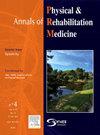Ulnar compound muscle action potentials predict hand muscle strength 1 year after cervical spinal cord injury: A retrospective analysis
IF 4.6
3区 医学
Q1 REHABILITATION
Annals of Physical and Rehabilitation Medicine
Pub Date : 2025-03-29
DOI:10.1016/j.rehab.2025.101959
引用次数: 0
Abstract
Background
Lower motor neuron (LMN) dysfunction caused by anterior horn cell damage in the ventral gray matter during spinal cord injury (SCI) may impact long-term prognosis.
Objectives
To determine the influence of the 3-month ulnar compound muscle action potentials (CMAP; representative of C8-T1 spinal segmental LMN integrity) on hand muscle strength and function, 12 months following SCI.
Methods
We completed retrospective analyses of the European Multicenter Study about SCI (EMSCI) database. Included participants had traumatic SCI (motor complete or incomplete), initial neurological level of injury C1-C8, and ulnar CMAP from the abductor digiti minimi in at least one limb, 3 months after injury. We trichotomized 3-month ulnar CMAP into absent (CMAP = 0.0 mV), reduced (CMAP <6.0 mV), and normal (CMAP ≥6.0 mV), and constructed logistical regression models to predict 12-month C8 and T1 motor scores, dichotomized into poor (≤3) and functional (>3). We explored relationships between trichotomized 3-month ulnar CMAP and 12-month functional Graded Redefined Assessment of Strength, Sensation and Prehension (GRASSP) and Spinal Cord Independence Measure (SCIM) upper limb sub-scales, using non-parametric statistics.
Results
Data from 318 participants (253 males), 46.8 years old (SD 18.4), resulted in CMAP and corresponding motor scores in 629 limbs. Adjusted logistical regression models were significant for C8 and T1 motor scores, with absent (C8 36.6, 95 % CI 12.9–133; T1 38.7, 95 % CI 11.2–24) and reduced (C8 11.0, 95 % CI 6.7–18.4; T1 7.93, 95 % CI 5.2–12.3) CMAP, predictive of poor 12-month motor scores. 12-month GRASSP (n = 30) and SCIM scores were significantly higher in those with normal 3-month ulnar CMAPs than absent and reduced.
Conclusion
There is a 7 to 38-fold higher likelihood that SCI individuals with reduced or absent 3-month ulnar CMAP will demonstrate poor hand motor scores at 12 months. This aligns with significantly worse GRASSP and SCIM functional scores. Our findings justify adding LMN health measures in prognostic modeling after SCI.
尺复合肌动作电位预测颈脊髓损伤后1年手部肌肉力量:回顾性分析
背景脊髓损伤(SCI)时腹侧灰质前角细胞损伤引起的下运动神经元(LMN)功能障碍可能影响长期预后。目的探讨3个月尺复合肌动作电位(CMAP)的影响;脊髓损伤后12个月手部肌肉力量和功能的变化(代表C8-T1脊柱节段性LMN完整性)。方法对欧洲多中心SCI研究(EMSCI)数据库进行回顾性分析。包括创伤性脊髓损伤(运动完全或不完全),初始神经损伤水平C1-C8,以及至少一个肢体的指外展肌尺侧CMAP,损伤后3个月。我们将3个月尺骨CMAP分为缺失(CMAP = 0.0 mV)、降低(CMAP <6.0 mV)和正常(CMAP≥6.0 mV),并构建逻辑回归模型预测12个月C8和T1运动评分,分为差(≤3)和功能(>3)。我们使用非参数统计方法探讨了3个月尺骨三分形CMAP与12个月的力量、感觉和抓握功能分级重新定义评估(GRASSP)和脊髓独立性测量(SCIM)上肢亚量表之间的关系。结果318名参与者(男性253名),年龄46.8岁(SD 18.4), 629条肢体有CMAP和相应的运动评分。调整后的逻辑回归模型对C8和T1运动评分具有显著意义,缺席(C8 36.6, 95% CI 12.9-133;T1 38.7, 95% CI 11.2-24)和降低(C8 11.0, 95% CI 6.7-18.4;T1为7.93,95% CI为5.2-12.3)CMAP,预测12个月运动评分差。3个月尺侧cmap正常的患者12个月GRASSP (n = 30)和SCIM评分明显高于无cmap或cmap降低的患者。结论:3个月尺骨CMAP减少或缺失的脊髓损伤患者在12个月时手部运动评分较差的可能性高出7 - 38倍。这与GRASSP和SCIM功能评分明显较差相一致。我们的发现证明在脊髓损伤后的预后模型中加入LMN健康指标是合理的。
本文章由计算机程序翻译,如有差异,请以英文原文为准。
求助全文
约1分钟内获得全文
求助全文
来源期刊

Annals of Physical and Rehabilitation Medicine
Medicine-Rehabilitation
CiteScore
7.80
自引率
4.30%
发文量
136
审稿时长
34 days
期刊介绍:
Annals of Physical and Rehabilitation Medicine covers all areas of Rehabilitation and Physical Medicine; such as: methods of evaluation of motor, sensory, cognitive and visceral impairments; acute and chronic musculoskeletal disorders and pain; disabilities in adult and children ; processes of rehabilitation in orthopaedic, rhumatological, neurological, cardiovascular, pulmonary and urological diseases.
 求助内容:
求助内容: 应助结果提醒方式:
应助结果提醒方式:


